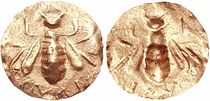Obols through history
Silver obol of Athens, dated 515–510 BC. Obv. Gorgoneion Rev. Incuse square.
Charon's obol. 5th–1st century BC.
A 19th-century obol from the British-occupied Ionian Islands
The obol (‹See Tfd›Greek: ὀβολός, obolos, also ὀβελός (obelós), ὀβελλός (obellós), ὀδελός (odelós). lit. "nail, metal spit";[1] Latin: obolus) was a form of ancient Greek currency and weight.





